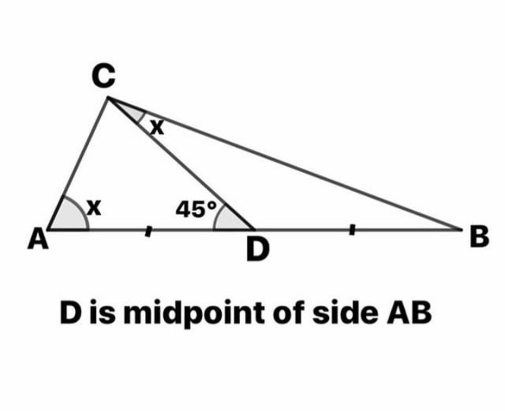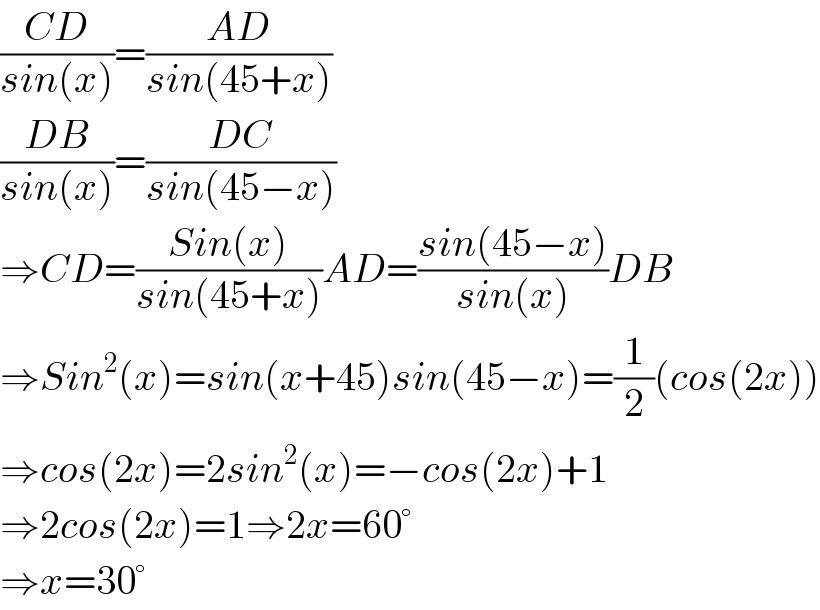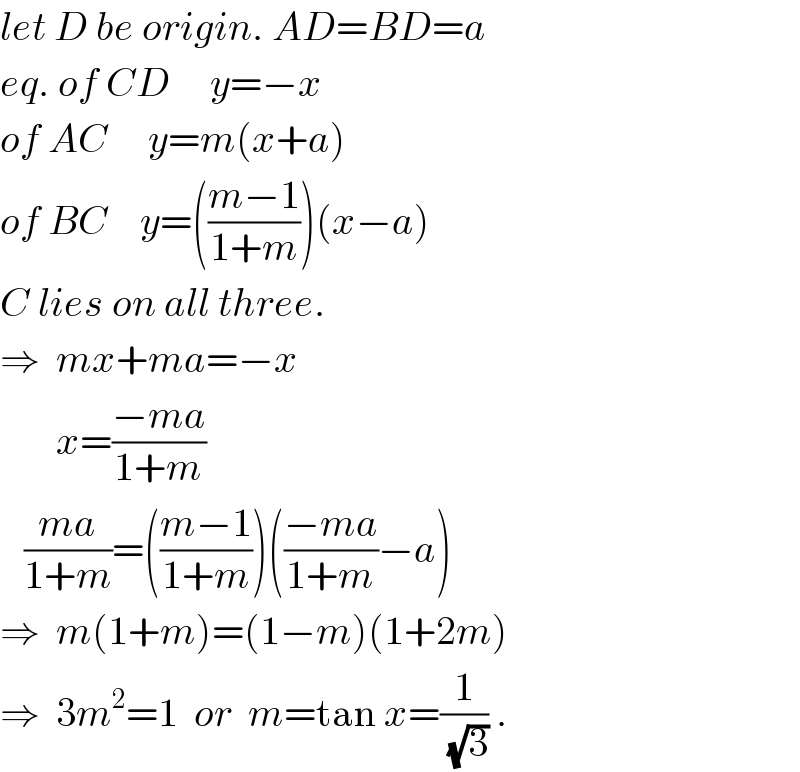Question Number 70826 by naka3546 last updated on 08/Oct/19

Commented by naka3546 last updated on 08/Oct/19

$${Find}\:\:{x}\:. \\ $$
Answered by mind is power last updated on 08/Oct/19

$$\frac{{CD}}{{sin}\left({x}\right)}=\frac{{AD}}{{sin}\left(\mathrm{45}+{x}\right)} \\ $$$$\frac{{DB}}{{sin}\left({x}\right)}=\frac{{DC}}{{sin}\left(\mathrm{45}−{x}\right)} \\ $$$$\Rightarrow{CD}=\frac{{Sin}\left({x}\right)}{{sin}\left(\mathrm{45}+{x}\right)}{AD}=\frac{{sin}\left(\mathrm{45}−{x}\right)}{{sin}\left({x}\right)}{DB} \\ $$$$\Rightarrow{Sin}^{\mathrm{2}} \left({x}\right)={sin}\left({x}+\mathrm{45}\right){sin}\left(\mathrm{45}−{x}\right)=\frac{\mathrm{1}}{\mathrm{2}}\left({cos}\left(\mathrm{2}{x}\right)\right) \\ $$$$\Rightarrow{cos}\left(\mathrm{2}{x}\right)=\mathrm{2}{sin}^{\mathrm{2}} \left({x}\right)=−{cos}\left(\mathrm{2}{x}\right)+\mathrm{1} \\ $$$$\Rightarrow\mathrm{2}{cos}\left(\mathrm{2}{x}\right)=\mathrm{1}\Rightarrow\mathrm{2}{x}=\mathrm{60}° \\ $$$$\Rightarrow{x}=\mathrm{30}° \\ $$
Commented by naka3546 last updated on 08/Oct/19

$${Can}\:\:{it}\:\:{solved}\:\:{without}\:\:{trigonometry}\:? \\ $$
Commented by mind is power last updated on 08/Oct/19

$${yes} \\ $$$$ \\ $$
Answered by ajfour last updated on 08/Oct/19

$${let}\:{D}\:{be}\:{origin}.\:{AD}={BD}={a} \\ $$$${eq}.\:{of}\:{CD}\:\:\:\:\:{y}=−{x} \\ $$$${of}\:{AC}\:\:\:\:\:{y}={m}\left({x}+{a}\right) \\ $$$${of}\:{BC}\:\:\:\:{y}=\left(\frac{{m}−\mathrm{1}}{\mathrm{1}+{m}}\right)\left({x}−{a}\right) \\ $$$${C}\:{lies}\:{on}\:{all}\:{three}. \\ $$$$\Rightarrow\:\:{mx}+{ma}=−{x} \\ $$$$\:\:\:\:\:\:\:{x}=\frac{−{ma}}{\mathrm{1}+{m}} \\ $$$$\:\:\:\frac{{ma}}{\mathrm{1}+{m}}=\left(\frac{{m}−\mathrm{1}}{\mathrm{1}+{m}}\right)\left(\frac{−{ma}}{\mathrm{1}+{m}}−{a}\right) \\ $$$$\Rightarrow\:\:{m}\left(\mathrm{1}+{m}\right)=\left(\mathrm{1}−{m}\right)\left(\mathrm{1}+\mathrm{2}{m}\right) \\ $$$$\Rightarrow\:\:\mathrm{3}{m}^{\mathrm{2}} =\mathrm{1}\:\:{or}\:\:{m}=\mathrm{tan}\:{x}=\frac{\mathrm{1}}{\:\sqrt{\mathrm{3}}}\:. \\ $$
